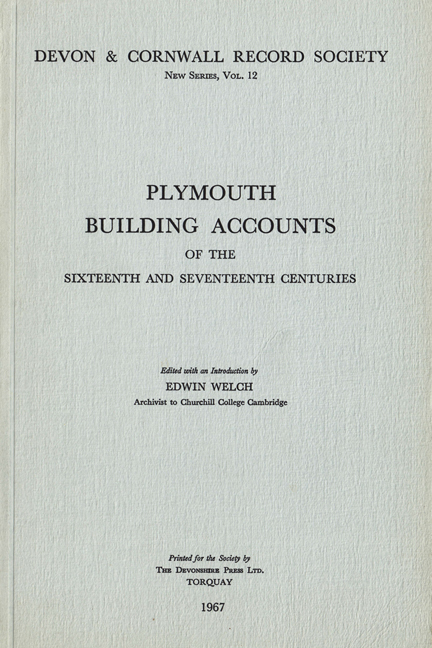Summary
PLYMOUTH has preserved very few of its old buildings. Nineteenth century improvements, twentieth century slum clearance, and bombing during the last War have destroyed almost everything of architectural or historical interest. Plymouth corporation has, however, preserved some of the most detailed building accounts in England and Wales.1 Whereas in most areas one can only expect a summary account or an occasional bill, and these less often than might be expected, in Plymouth there are several surviving account books which list the names of the workmen employed, the materials used, and their origin, and even the number of nails required. Unfortunately, not one of the buildings concerned still survives, so that it is impossible to compare an existing structure with the record of its construction. Therefore the accounts printed have been chosen for their own interest and no attempt has been made to provide a history of building in Plymouth during the seventeenth century.
The Manuscripts
The first accounts printed in this volume are taken from the general series of corporation receivers’ accounts for the year from Michaelmas 1564 to Michaelmas 1565. The building is not named in these accounts, but it can be identified with reasonable certainty as the Guildhall which was rebuilt at this time. The accounts are found on folios 14 to 26 of the volume numbered 131 by R. N. Worth when he listed the corporation archives at the end of the last century.2 It is the smallest volume of receivers’ accounts and consists of a single gathering of 67 paper folios sewn together through three strips of parchment. In the nineteenth century someone (probably R. N. Worth) has pasted on a cover of brown paper to protect the outside pages.
As was usual for corporation accounts in the sixteenth and seventeenth centuries it begins with the receipts of the corporation from the leasing of property, harbour dues, and profits of franchises. The disbursements begin with the fees payable to corporation officials, followed by the usual items of expenditure—gifts to the poor and to companies of actors, presents for persons of influence, and fees for legal advice. From folio 17 onwards the accounts are chiefly concerned with the erection of a new building and the repair of the town barge after it had been wrecked in the Sound.
- Type
- Chapter
- Information
- Plymouth Building Accounts of the 16th and 17th Centuries , pp. vii - xviiiPublisher: Boydell & BrewerPrint publication year: 1967



